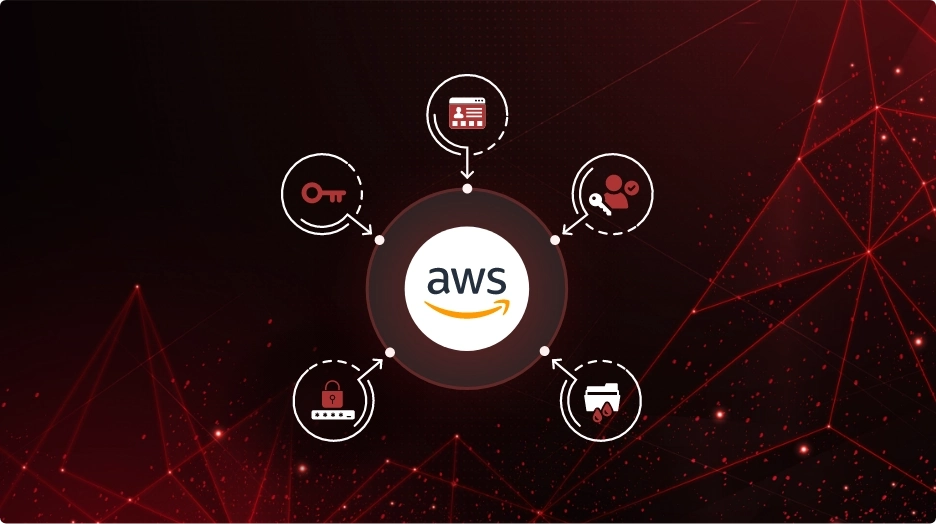Top InfoSec Innovator for SaaS Security Posture Management (SSPM)


CheckRed Editorial
Amazon Web Services (AWS) is a top choice for cloud computing services. AWS plays a pivotal role in digital transformation, serving as the foundation of countless businesses and applications. Authentication, the process of verifying the identity of users and systems, is the cornerstone of AWS security. Understanding the importance of authentication is crucial because any lapse in this process can lead to dire consequences. In this blog, we’ll explore five key authentication risks that are prevalent in AWS.

Orphan accounts in your AWS environment are unused user accounts or permissions that are no longer needed. These are accounts that once belonged to employees who no longer work in the organization, or that were made temporarily and then forgotten. Malicious actors frequently target orphan accounts when looking to get unauthorized access to your AWS resources.
Employee turnover, neglecting to delete temporary accounts, or failing to adjust access rights when job roles change are common reasons for orphan accounts in AWS. These accounts are quite likely to be overlooked as AWS setups become more complicated.
Orphan accounts have important security repercussions. They increase the attack surface of your infrastructure, provide unauthorized access to sensitive data, and result in compliance violations. Regularly identifying and eliminating these accounts will help you keep a strong security posture by making sure that no one but authorized users can access your AWS resources.
Secure shell, or Secure socket shell (SSH), is a protocol for remote computer access, and it refers to the tools implementing it. SSH establishes a secure, encrypted connection between a user’s device and a remote server. To use it, you need an SSH client and a server with an SSH daemon running.
Authentication methods include passwords and public keys. Public keys, comprising a pair (private and public), enhance security. Passwords, on the other hand, are less secure as they rely on easily guessable information.
Weak SSH authentication poses substantial risks, including unauthorized access, data breaches, and the potential for attackers to gain control over your infrastructure. Misconfigured SSH keys or poor management practices can lead to vulnerabilities that threat actors exploit.
Best practices for SSH key management involve generating strong, unique keys, restricting key access, and regularly rotating keys. Utilizing SSH certificates, implementing multi-factor authentication, and monitoring SSH access logs are crucial steps to enhance security.
Cross-account access refers to the ability of one AWS account to interact with resources and services in another AWS account. While this capability can streamline operations, it introduces multiple risks. Unauthorized access to sensitive resources can occur when cross-account permissions are misconfigured or overly permissive, compromising the security of both accounts.
The threats associated with cross-account access include data breaches, unauthorized resource manipulation, and escalation of privileges. Malicious actors can exploit misconfigurations to move laterally within your AWS environment, potentially causing widespread damage.
Securing cross-account access involves implementing the principle of least privilege, ensuring that permissions are narrowly scoped to only what’s necessary. Regularly reviewing and auditing cross-account access policies, conducting access reviews, and utilizing AWS Organizations for centralized management are effective strategies.
A robust password policy is paramount to AWS security. Passwords are the primary step against unauthorized access. A strong policy ensures that passwords are complex, hard to guess, and regularly updated, significantly enhancing the protection of your AWS resources.
Weak password policies expose AWS environments to several risks, including brute force attacks and unauthorized account access. Attackers often exploit weak passwords as an entry point to compromise your infrastructure and exploit sensitive data.
Every organization must have a strong system in place that monitors and alerts password-related security risks. It is also important to enforce password changes at regular intervals, educate users on password best practices, and implement multi-factor authentication (MFA) to add an extra layer of security. Regularly audit and update your password policy to adapt to evolving threats and ensure compliance.
Access keys play a pivotal role in AWS authentication, serving as the credentials for programmatic access to your AWS resources. They consist of an access key ID and a secret access key, granting permissions to interact with AWS services through APIs and CLI commands.
Outdated or unused access keys pose significant security risks. Unauthorized individuals who gain access to old or forgotten keys may exploit them to compromise your AWS resources, potentially leading to data breaches or resource misuse.
Mitigating risks from old access keys requires organizations to establish practices for managing and rotating access keys. Regularly audit your AWS environment to identify and deactivate unused keys. Implement automated key rotation policies to ensure that access keys are continually updated, reducing the window of vulnerability. Additionally, consider using AWS Identity and Access Management (IAM) roles and temporary security credentials for more secure and controlled access.
CheckRed is a comprehensive and powerful SSPM and CSPM platform. It provides end-to-end security posture management for AWS environments. CheckRed excels in real-time risk detection and guided remediation. It constantly monitors AWS configurations and access controls, swiftly identifies any deviations from secure policies, and generates remediation workflows so you can mitigate risks promptly.
With its consistent compliance checks and prioritized alert capabilities, CheckRed helps you ensure that your AWS environment adheres to industry standards and your organization’s security policies. Leveraging CheckRed offers numerous benefits, including enhanced AWS authentication security, tailored frameworks, reduced risk of misconfigurations, and improved compliance, making it an indispensable solution for safeguarding your AWS assets.
In conclusion, safeguarding AWS authentication is crucial for any organization that heavily relies on its cloud computing solutions. Proactive security measures are crucial to protecting your AWS environment from misconfigurations and compliance violations. Implementing CheckRed as your solution for robust AWS security posture ensures that you are always one step ahead of security risks and threats, and that your organization thrives in a secure landscape.
Dive into the future with our interactive demo
and explore the possibilities.
Related Posts